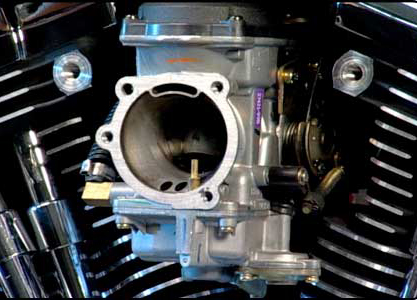The other day a Harley magazine advertisement caught my eye entitled The Cure for the Common CV. The "adicle" (Advertisement that mimics an article) started by asking if your stock CV carburetor on your Harley is worn out or in need of a major rebuild, with the intention of selling their brand of aftermarket carburetor as a replacement.
 I thought I'd share my own insights and clear up some common misunderstandings about the stock Harley carburetor. Let me first preface this by saying I have nothing against the advertiser (to remain nameless) whose ad I am referencing, and over the years I have recommended them for certain non-stock and race applications. I thought I'd share my own insights and clear up some common misunderstandings about the stock Harley carburetor. Let me first preface this by saying I have nothing against the advertiser (to remain nameless) whose ad I am referencing, and over the years I have recommended them for certain non-stock and race applications.
Let's start with the title, "The Cure for the Common CV". The only thing common about the Harley CV carburetor would be that over 3 million Harley's were outfitted with these versatile carbs from the factory.
The CV carburetor's ability to adapt to changing engine conditions all while keeping up with emission standards allowed Harley motorcycles to continue using this carburetor virtually unchanged from 1989 to 2006.
Unlike aftermarket carburetors using throttle controlled slides or butterfly valves, the Harley CV made by Keihin uses a vacuum actuated slide. The unique design constantly changes the size of the venturi (throat) based on manifold vacuum while simultaneously metering the air/fuel delivery. All of this occurs independent of the throttle unlike the "common" aftermarket carburetors. The name "CV" is derived from the design which maintains a Constant Velocity of flow which describes these carburetors perfectly.
Based on the above, I would say the CV carburetor is anything but common.
Throwing out the baby with the bath water
The ad recommends replacement of the CV carb if it is worn or running poorly and lists the benefits of their aftermarket brand. In regards to a CV carburetor being worn, the majority of parts that could become worn are few and are easier to replace as opposed to installing a new carburetor. Poor running conditions are easily overcome with simple upgrades and part replacements. Other performance improvements are also available that will awaken the CV carburetor beyond it's undeserving mild mannered reputation.
Before replacing your stock CV carburetor, be aware that doing so is a violation or illegal in some states. Other local regulations could require you to maintain the factory stock carburetor for emission testing or when transferring ownership. Keep this in mind before deciding to replace the otherwise perfectly good carburetor - already capable of delivering plenty of performance on it's own.
When to choose aftermarket over stock
While the Harley CV can become a performance carburetor with the right tuning and components, there are circumstances where stepping up to an aftermarket carburetor may be necessary. This includes racing or big bore builds that stretch the original CV beyond its limit. Jetting and tuning can adapt the original carburetor all the way up to a 95" big bore or slightly higher with some modifications, including high revving Buell models or bikes with wild cams.
Engine displacements 100 inches and higher or racing applications lend themselves to aftermarket carburetors where daily driving and gas mileage are less of a concern. That is not to say that you cannot use one of those carburetors on your daily stock ride, but the hidden performance in the CV carb you already have may surprise you. For years builders have opted for the larger aftermarket carburetors with the belief that bigger is better. Recent trends at shows and meets have seen builders and riders getting back to the tried and true CV carburetor.
Many have regretted giving up this reliable component which has since created a new demand and premium for them. Just be weary of the knock-off CV carbs out there which can be spotted by their lack of Harley branding cast into the body. These copies may have parts that are not interchangeable leaving you high and dry when it comes time to find replacement parts.
I may be a bit biased when it comes to the CV carburetor and my passion for their effective design. I've been rebuilding, tuning and dedicated to improving their performance since Harley began using them in 1988. To me they are anything but common.
Ken - CVP
|